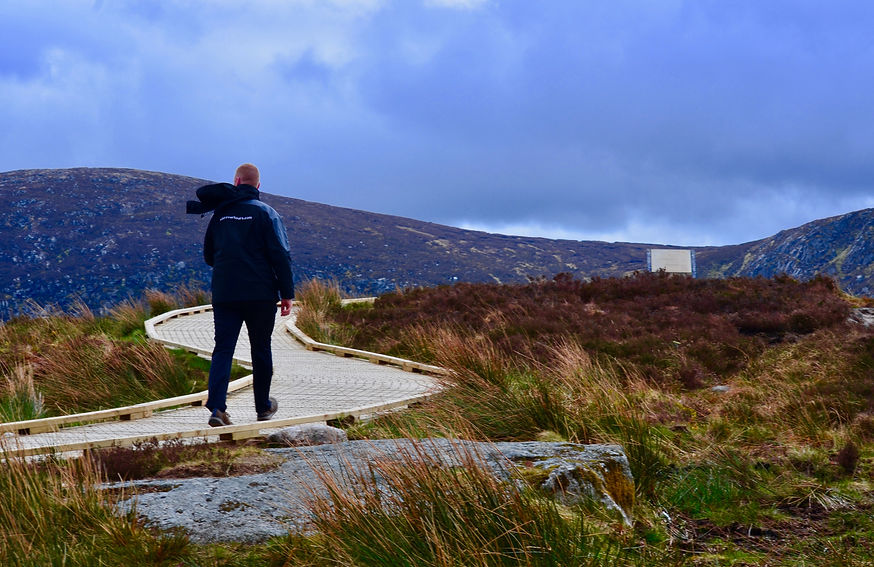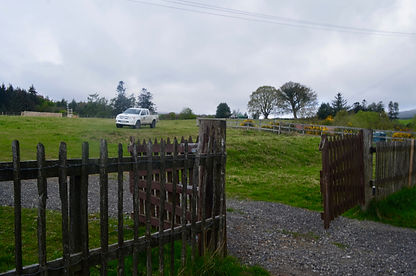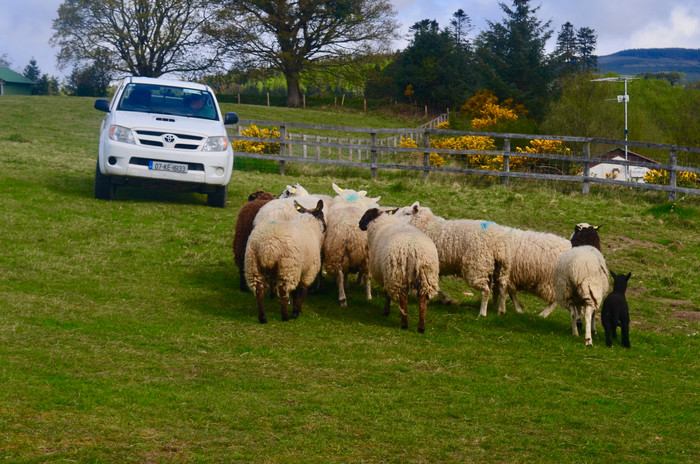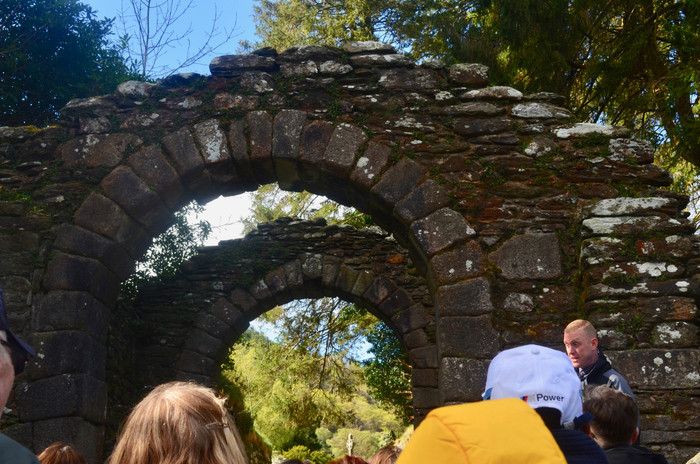
Wicklow

UK & IRELAND diary : Day 17 - 27th April 2017
The Wicklow town is to the South of Dublin City, in the County Wicklow. It is the most mountainous region in Ireland and is also referred to as the "Garden of Ireland". The low land gradually grows to form Mountains on its west- the renowned WICKLOW MOUNTAINS. During the 8th Century , the Vikings launched a series of raids around this area and Wicklow served them as a natural harbour.
We were up early that morning and once again boarded a local bus at Clonskeagh to reach the GRESHAM HOTEL in Dublin Centre. The WILD ROVERS TOUR bus arrived at 7:30 am sharp and we soon sped towards County Wicklow. Visiting the town of Wicklow was not a part of the day's Itinerary.
Gliding through gorgeous landscapes, strewn with yellow flowers, high and low with the guide sharing loads of interesting facts was how the tour progressed. The yellow flora were the GORSE flowers, also referred to as FURZE. They are also known by a couple of other names. They bloom throughout the year and their petals are used in making a special wine, due to their edible nature. Earlier, they were used in production of Irish Whisky to provide it the required golden colour, apart from adding a mild almond flavour to it. With loads of other such stories, time flew past. In an hour's time, we reached the "ANNAMOE FARMS". We were welcomed at the gate of the farm by a SHEEP DOG. The surroundings kept us in awe and our cameras got busy. The guide had already informed us of the attraction here. The farm hosted us that morning, to witness a demo of their favourite sheep dog in action.
The sheep dog trainer introduced himself & the little dog to the group. The dog was just 2 years old. He was trained since his puppy days to be a "SHEEP DOG". We gathered around the paddock, where a dozen fluffy sheep were seen. It was delightful to hear the mild bleating of sheep. The trainer then let the flock out. While the sheep climbed the meadow and moved far away, he explained the use of "Sheep dogs" to senior farmers & sheep rearers, who found climbing hills and mountains challenging, in pursuit of bringing back their sheep home. The trained dogs would instead do that for them. We noticed that the sheep had moved quite a distance by then.

The trainer signalled his dog with various whistles, which the dog seemed to recognise. It followed his instructions accordingly. Soon the intelligent dog managed to gather all the sheep & bring them safely, back to the paddock. It was simply outstanding to watch . Do not forget to watch the video of this event , uploaded in the gallery here. Our morning was totally brightened up by this experience. Before long, we bid a fond farewell to the sheep and the cute dog and moved on, in our journey for the day.
Our next stop was at the famous, prehistoric, monastic city of GLENDALOUGH. Set in the glacial valley, right inside the WICKLOW MOUNTAINS NATIONAL PARK, is the ancient monastic city of Glendalough. It is as old as 6th century. The place attracts a lot of visitors throughout the year due to its walking trails, deep history & couple of swell lakes. From the moment we set foot here, it was pure bliss. The surroundings were filled with pure oxygen, we could feel it in our lungs. We walked behind the guide, who led us through the main double arched, stone gateway to the monastic city, the roof of which was in dilapidated.
Years ago St. Kevin decided to turn a hermit and seek peace in solitude. He therefore moved to this place and lived a simple life. Shortly after, other men in pursuit of similar life style, happened to move in here. They were inspired by St. Kevin and turned his followers. The place, therefore, soon turned into a monastery.
We stopped in front of a stone house like building, with a longish pillar peeping from its roof, most likely a chimney. The guide laughed at our guess and confirmed we were not the only ones who thought that way. We were taken aback to hear that it was the ST. KEVIN's church. The pillar was its roundish bell tower. As the structure wore a residential look, with its protruding "chimney like" tower, it also came to be known as " Kevin's kitchen". The roof of the church was built of stones placed atop each other, cascading downward. The entry inside this church was, however, prohibited. The setting of the church and its backdrop seemed to form an ideal film location.
A little away from the Church area was the tall standing round tower. Apart from being 1000 years old, we were informed that the peculiarity of this tower was its little doorway, that lay at a height of at least 6-7 feet from the ground.
This entrance to the tower was supposedly accessed by a wooden ladder, that could be removed immediately after usage. It was built as a defence mechanism to seek refuge from sudden attacks. We walked around the area and found a lot of tomb stones. The History and significance of a few important Celtic crosses installed there, were detailed. It was explained that the churches of Glendalough had all been abandoned after the reformation. The area thereafter totally turned into a burial ground. Around 2000 tomb stones can be found as on date there. We slowly assimilated all the information despite the more alluring scenery, under the bright blue sky.
The guide time was soon over. We were free to explore the place on our own. The guide directed our attention to a stone (size of a huge grinding stone) on the main path, having a hole in it, now filled with a little water. He asked us to guess what that might be, to which many replied "Grinding stone".. He smiled and replied "No... it's an ancient commode" .. to which all of us laughed. Not sure if that was the fact. A pathway from the monastic city led inside the park area. The crowd dispersed. A pathway from the monastic city led inside the park area. This further led to two lakes, The upper & lower lake. We walked towards the lower lake, as it fell within a shorter distance, savouring the scenic delights all along the winding, hilly roads.




We got to cross a wild bridge, with the majestic mountains in the backdrop. The History goes that these two Lakes in fact, allured pilgrims earlier, due to the belief in their " SIN healing powers". The tranquil surroundings put our minds at peace. No wonder St. Kevin chose this place. We reached the lower lake. The setting was stunning with mixture of yellow, green, brown and of course, the water & sky. We spent a while here, playing with water, before we headed to the entrance. We had to skip the UPPER LAKE due to its distance. We returned finally, after spending more than an hour. The tour operator instructed us to gather around the bus. We were on our way to the next destination - The WICKLOW GAP.
We hit the highway and raced through the mountainous terrain for a short while. We were now crossing the Wicklow mountain range on the R756 highway. There are only two routes crossing the Wicklow mountains from west to east, one is the Sally Gap and the other is the Wicklow gap. The Wicklow gap is the road stretching for about 27 kilometres from the Villages of HOLLYWOOD to LARAGH, in the country WICKLOW. This is a more scenic route than the Sally Gap , making it popular among tourists. We reached the view point named BEARNA CHILL MHANTAIN ( in other words the Wicklow gap ). Our bus came to a halt along a roadside, on the nearly deserted highway, surrounded by brownish mountains. Our guide got off the bus. We followed him on a wooden track, snaking up the mountain. It was nail biting cold and the wind was blowing strongly. Most of the passengers decided to stay inside the vehicle due to the weather condition. A few of us were looking forward to capture aerial views. We came to a stop at a nearly octagonal shaped wooden flooring on the hilltop, with a display board detailing the history of the place. We spotted the brown mountain range running far, far away. It was a short stop but well worth it. We got back to our bus and continued our return journey to Dublin City. We further took a local bus from O' Connell street, to reach our Airbnb accommodation in Clonskeagh, Dublin. This was end of day 17 of our tour.





























































































































